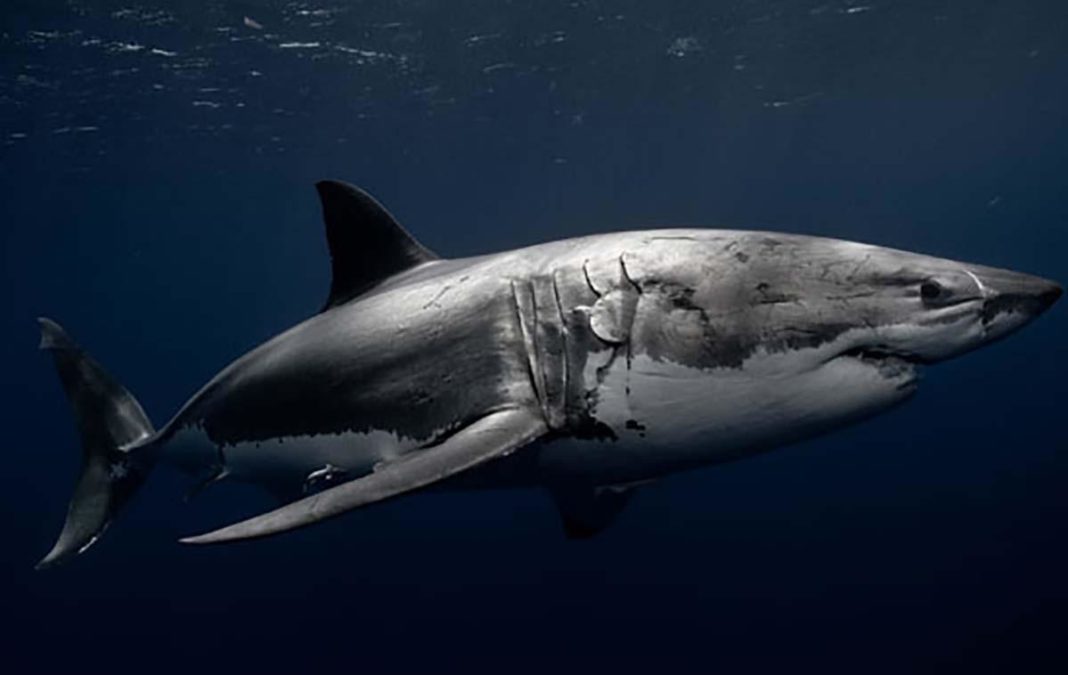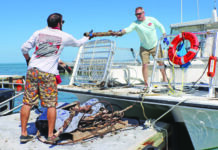April and May have been big months for big sharks in the Keys. In mid-April, a fisherman named Carter Bates posted a video online of a white shark devouring a chum bag, and it went viral. He estimated the shark was 16 feet long. Then, a couple weeks later, Knee Deep charter boat owners Barbie and Kevin Wilson spotted another great white, about six miles off Geiger Key. Barbie described it as “huge.” Neither Bates nor the Wilsons expressed feeling in danger during the episodes, and the Wilsons described the shark as uninterested in a bonita they threw it.
Yet, comments online included sentiments like “No more snorkeling in Key West” and “Can someone shoot it?”
Terror is the knee-jerk reaction when it comes to these apex predators.
The reputation of white sharks continues to have a big, dorsal-fin-shaped shadow cast on it, likely since Steven Spielberg decided to make a movie out of Peter Benchley’s book “Jaws” in 1974. Yet people who actually spend their time on the water – divers, fishermen, boat captains and marine scientists – don’t maintain those attitudes.
The warm, shallow waters of the Florida Keys are not a typical hangout spot for white sharks — no density of activity like off the coast of California, or the waters off the tip of South Africa.
But what does the recent evidence of white shark activity in the Keys tell us?
Not much, says Dr. Rob Nowicki, a research fellow at Mote Marine Laboratory, whose expertise lies in how climate change affects apex predators — like white sharks.
“These opportunistic photos and videos are not standardized any way,” he said. “We need to not just look at sightings and videos, but also how many people have chum bags, how many are taking photos. It’s really hard to create a pattern from these videos.” As smart phones become more common, the opportunities for people to capture such images have gone up. “That doesn’t mean that people here weren’t seeing them before,” said Nowicki.
Nowicki points to the value in the great white videos: it indicates the sharks’ seasonal migration. We are also in the time of seasonal migration for birds, so many species are passing through — in the air or under the water — to feeding and mating grounds. Nowicki says it’s impossible to diagnose changes in behavioral patterns without establishing baselines — which scientists are on their way to establishing with whites.
Organizations like Ocearch, a group that uses advanced tracking technology to follow white sharks, among other species, are offering scientists a clearer picture of the seasonal migration patterns. Last year showed an increase of white sharks swimming through waters surrounding the Keys. Anyone interested can check out Ocearch’s shark tracker online. It currently places an 11-foot male white shark named Nova around the Dry Tortugas and a female white shark named Miss Costa further up the coast in the Gulf, parallel to Tampa. Indeed, Ocearch shows more sharks of other types in our part of the ocean: makos, hammerheads, tigers and bulls, with the occasional white — their numbers increase in colder water in the Northeast.
Patrick Rice, chief science and research officer at Florida Keys Community College, notes that whites, like other migratory species, follow the movement of their food.
“These sharks are following tuna and marlins that are going to the Gulf of Mexico to spawn,” he said. “They follow the big migratory species: bluefin tuna, yellowfin tuna and blue marlin.” They follow large pelagic fish, which are the species that live in the open ocean, rather than at the bottom of the sea.
We do know that climate change is changing some aspects of shark ecology. Scientists like Charles Bangley, a postdoctoral fellow at the Fish and Invertebrate Ecology lab of the Smithsonian, published a paper showing that bull sharks have shifted their nursing grounds from Florida to North Carolina. According to the Smithsonian, Bangley’s work posits that sharks may be the “first responders to climate change.”
So we may see changes in migratory patterns of whites, but that’s not what the Keys sightings are evidence of. Other factors, however, like shark conservation legislation, have encouraged growing numbers of whites in the Atlantic.
“White sharks are protected,” said Rice. “There was a law that was enacted in 1993 that protected them, so populations are rebounding. There is an increase in sharks and increase of people going in the water; there will be an increase in encounters.”
Rice references a study that attributes the perceived population increases to the 1993 implementation of the U.S. National Marine Fisheries Service (NMFS) Fishery Management Plan (FMP) for sharks of the Atlantic Ocean.
Indeed, Florida Fish and Wildlife Conservation Commission spokesperson Amanda Nalley confirms that great whites are prohibited from harvest.
“That means that anglers who hook one are required to release it as quickly as possible. Beginning July 1, shark anglers will be required to meet even more stringent details such as requiring the shark to stay in the water, and requiring anglers to have some type of device to cut the steel leader quickly.”
Why is it crucial to protect these shark species, especially in places populated with boaters and swimmers?
“These large shark species are apex predators,” said Nowicki, “and they deserve the respect that any apex predator deserves, whether on land or water.” They are also irreplaceable — the loss of apex predators, because of their position at the top of the food chain, can have disproportionate affects on a marine ecosystem. “They can impact entire populations of prey just by being present: what they do, where they go, what they eat, how they eat. These cascades are really important for ecosystems.”
So we should leave them alone, right? Not exactly. The good news is that bites are very uncommon in the Keys, and almost never fatal. “Most shark attacks occur because someone is standing in murky water, and they take an investigatory bite,” said Rice. Most “attacks” (a misnomer — they are nearly always investigatory bites) with great whites are because of surfing, wherein the person floating on a surf board looks a lot like a seal. We don’t have a lot of surfing in the Keys, and we often enjoy clear water, so we aren’t a prime location for these encounters.
To combat what Nowicki calls the “Jaws effect,” – responses of horror and fear in the face of white sharks – he recommends moving away from sensationalist media that focus on attack tropes. “Folks need to spend some time with these animals, in an aquarium or out in the wild. I encourage people to get dive certified.” Nowicki says he prepares amateur divers before diving wrecks that may attract sharks by telling them that if they are afraid, they can come back to the surface, no questions asked. But that’s never what happens. “Once you spend some time around the animals, you see they aren’t hunting/killing machines, as they are portrayed. They are big predators that deserve respect, but aren’t out to get people.”
So as it turns out, maybe it is safe to get back in the water.
—Sara Matthis contributed to this report
Great White Shark Facts
White sharks have ampullae of Lorenzini, special sensing organs that function as electroreceptors, which detect electrical signals generated by fish or other organisms’ muscles contracting. There is no comparable sense in humans.
The white shark is an “apex predator,” which means that it is at the top of the food chain. The only known natural predator of white sharks is the killer whale.
White sharks were first described by Carl Linnaeus, the “father of modern taxonomy” in his “Systema Naturae” in 1758, though fossils date the species back 16 million years.
In January, divers off Oahu, Hawaii, took photographs of what is believed to be the largest shark ever recorded, named “Deep Blue” and estimated to be 50 years old and weigh 2.5 tons.
There is a “white shark café,” between California and Hawaii in the Pacific Ocean, where tagging projects have shown a high volume of whites hanging out. It hasn’t been established if this is where whites are having their pups, though scientists have posited theories about Pacific and Gulf grounds for having pups.
Rice and partners Eric Stroud and James Hanson developed Shark Defense, a chemical repellent based on necromone, the chemical released from putrified sharks, which can help repel sharks and reduce bycatch for fisheries.























